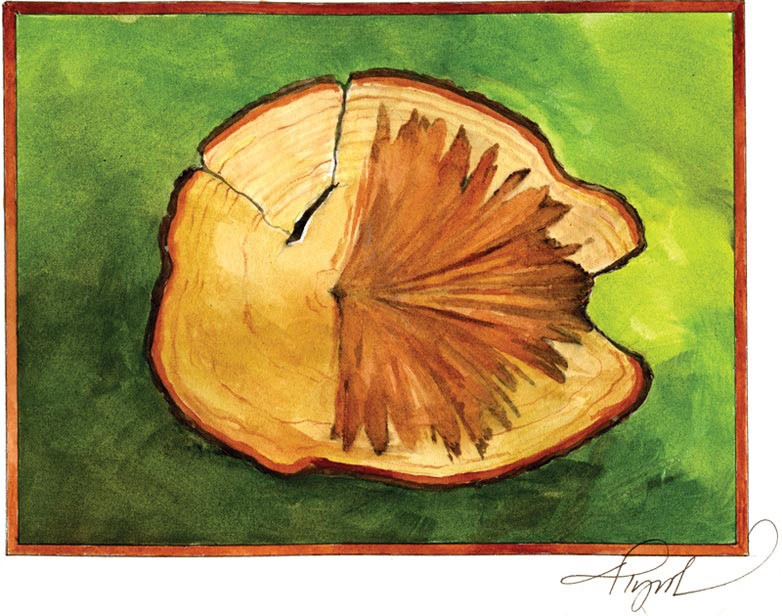
On a walk through a still, snowy sugarbush, the peacefulness can be overwhelming; everything looks to be in good order. But all may not be as perfect as it seems. In any sugarbush, there is a good chance that a fungal intruder has gained entry and is wintering unseen beneath the rich, dark bark of an unlucky sugar maple. If this invader is sapstreak disease, then death is likely to soon claim a valuable sap producer.
This fungus mainly affects sugar maples, and, because it enters trees through wounds in the lower part of the trunk or in the roots, it is more common in sugarbushes than in less frequently visited forests. Here there is more machinery, more intense management, and, especially when buckets are used instead of tubing, a lot more traffic. Sooner or later this will result in injury to a tree.
The sapstreak fungus colonizes sapwood; as it spreads, it disrupts the flow of water and nutrients from the roots to the rest of the tree. Long before there are any outward signs, a cross section of an infected tree shows a dark red or brown stain, with radiating streaks in a star-shaped pattern that give the fungus its common name.
It’s after sugaring is over that the symptoms of sapstreak disease become visible. An early summer inspection of the bush should be a shady affair, beneath the dark green leaves of well-tended trees. The first visible symptom of sapstreak is likely to be from just one tree, a tree that fails to intercept the sun as well as its neighbors, allowing a worrying amount of sunlight to penetrate the canopy. During the early stages of this disease, there are plenty of leaves, but on part or all of the crown, each leaf is smaller than normal. In subsequent years, the leaves become off-color and sparse and the crown dies bit by bit. Typically, the whole tree is dead within four years. Armillaria, an omnipresent, opportunistic fungus, often moves in to hasten the process.
Most trees with sapstreak disease are along roads or skid trails, or near the sugarhouse where comings and goings are intensified. Wounds to the roots or to the base of the tree are invariably present. Cattle in forests also cause wounds that allow sapstreak to enter – another reason to keep them out of the woods. Wounds created in spring and summer seem to be more susceptible to sapstreak disease than winter injuries, but, of course, it isn’t practical to stay out of a sugarbush in early spring.
When timber harvesting results in wounds to a large number of trees, sapstreak disease may become a more widespread killer, with symptoms showing up three to six years after the careless logging.
Why this fungus does not infect wounds higher in the tree is not known. If spores from sapstreak are introduced into tapholes, they almost always fail to cause disease. And when an infection is initiated high in a tree, the tree succeeds in walling it off so that it does not spread. Wounds to branches rarely, if ever, get infected by sapstreak. There is some evidence that the insects that carry sapstreak spores from tree to tree are ground dwellers, but that doesn’t explain why the disease does not develop in experimentally inoculated tapholes.
When a tree infected by sapstreak is cut down, the fungus may produce abundant sticky spores in a mat over the stained surface of the wood. Some researchers believe it is important to remove infected trees to reduce the number of spores, but since the fungus is very common, this may not be worthwhile.
The value of the lowest log on the bole, which is usually the best log, is greatly reduced because of the discolored wood. Dissection of sapstreak-killed trees shows that stain columns do not extend very far up into the trunk but that the root collar and roots are completely colonized.
On a more cheerful note, this disease rarely kills a large number of trees at one time. Single trees or small groups of trees – and only those that have been wounded – will die from time to time. Although not identified until 1935, sapstreak is a native disease and one that, so far, does not seem to have spread to other countries.

